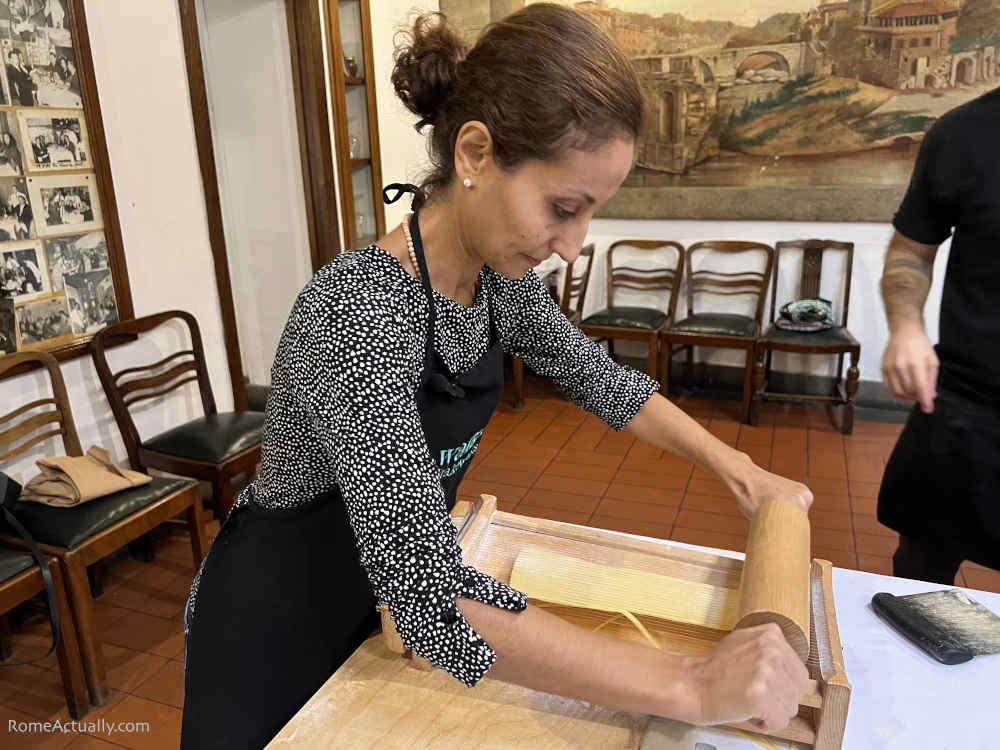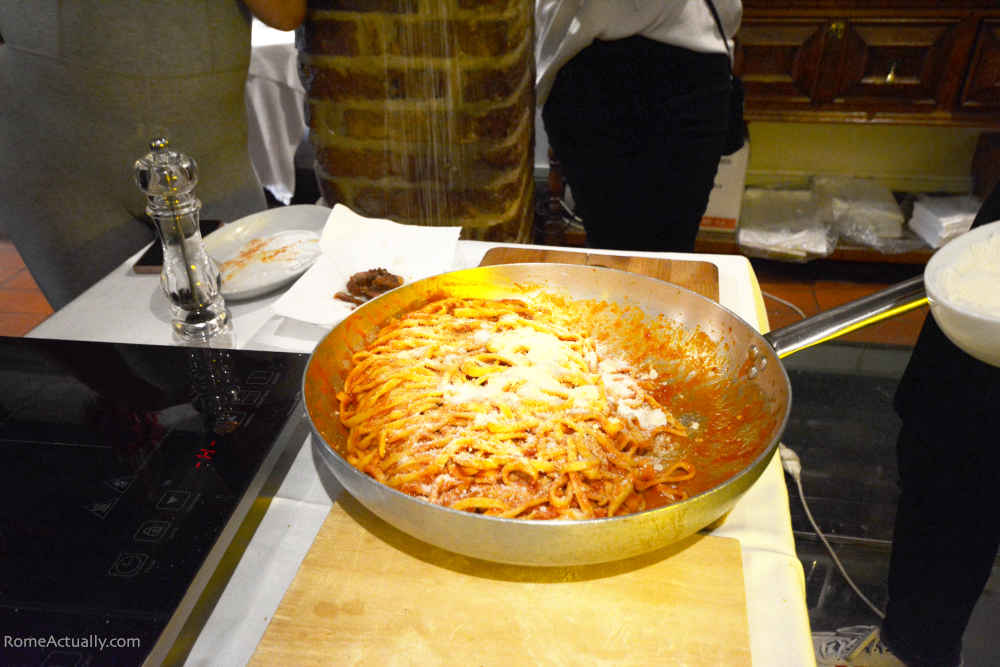So you are planning a trip to Rome and food plays a big role in the success of your vacation. You have been hearing and reading about Roman traditional cuisine all over social media and can’t wait to try it yourself. Chances are you are going to love it, so booking a Rome pasta-making class is a perfect way to feel still on holiday once you are back home and surprise your friends and family with a professional Roman meal.
I love sampling traditional dishes and learning how they came to be, but I admit, I’m not the best cook you will find in Italy. I do enjoy my time in the kitchen, and I like to experiment, but not always do my endeavors pay off. This is why I was happy to take this pasta-making class in Rome. Now, I can safely say that I can make at least one full traditional meal the right way and look like a professional chef with my guests.
This cooking class runs both in the morning and in the evening. It’s exactly the same experience, with the only difference that while in the evening it starts with a glass of Prosecco wine, the morning can hardly begin in the same way. Fret not, you will have your Prosecco once your dough is made!
I’m going through the different steps of this exciting Rome pasta-making class, what you will learn, and why I think it’s an experience every foodie and non should take. Probably if you are visiting Rome in a day, you are going to stick to the main attractions, but if you are staying two days or can even afford a whole week, I totally recommend this experience.
For more culinary adventures, check out our guide to the best cooking classes in Rome!

Why a pasta-making class in Trastevere
A former working-class district that went through a heavy gentrification process, Trastevere is today a popular neighborhood teeming with tourists. Hardly a best-kept secret, Trastevere has somehow managed to retain its original charm, and also locals never tire of hanging out along its cobbled alleys and historical buildings.
If you have already explored the neighborhood, visited its churches and main landmarks, and tried some of the best Trastevere restaurants, a cooking class is what you need. This is not a general, all-theory cooking lesson but a fully practical pasta-making class where you will be expected to knead, stretch the dough out, cut it into fettuccine, follow along when the sauce is being prepared and finally cook your pasta.
In a nutshell, your hands are going to get dirty, but then you get to eat your own pasta and trust me, it’s going to be worth it.
Don’t miss our article on the best things to do in Trastevere.

My experience in this Trastevere Pasta-Making Class
In this Rome pasta-making class we were accompanied by two chefs, Roberto in charge of our fettuccine, and Manuela in charge of teaching us one of Rome’s most cherished pasta sauces.
After the necessary introduction, the no-frill class kicked off. All explanations and demonstrations were clear from the beginning and easy to follow. I do like to make my own (amateur) bread and piadina at home, but egg-based fettuccine was a first.
Now, apron on, let’s get cooking!
You can book the same cooking class I took by clicking here!
Making the dough
The dough was new to me. Coming from Sardinia, I had always seen fresh pasta made with semolina and water. All the regions of Italy have their own dishes and ways of cooking. Associating northern and central Italian traditions, the class combined a Roman sauce with the egg-based pasta typical from the Emilia-Romagna region.
Our group of earnest students was organized into two tables set up with one working station for each wannabe cook. Equipped with our allotted semolina flour and egg, cutting board and fork, we followed the instructions and started working on our dish. First, we formed a volcano-style hole in our flour, we cracked our egg and poured it on it.
Gradually mixing it and blending it with the flour following our teacher Roberto’s technique, we formed a smooth dough ball and let it rest during the time we prepared the sauce.

Making the sauce
To meet the needs of one of the participants, we made not one but two sauces. Similar but occupying a distinct place in the hall of fame of Roman cuisine, when you learn how to make both amatriciana and gricia in one go, it’s a good day.
The main sauce we made to season our pasta was amatriciana. Preparation-wise, it’s pretty simple because it requires very few ingredients: tomato sauce, guanciale (cured pork cheek), and Pecorino Romano cheese. That’s it. No oil, no parmesan, and don’t even think about butter. A famous Italian chef confessed he added onion to his amatriciana: Romans didn’t appreciate what they believed was a joke.



The secret is to pick high-quality ingredients. If you are in Rome, after this class is over, go grocery shopping for guanciale and pecorino and take home with you a piece of local Roman flavors. Check with the rules of your country and airline if you can fly with these food products. I think Pecorino cheese is not an issue, but guanciale probably is for US travelers.
Using the Italian pancetta (cured pork belly) or American bacon is not the same thing. Even in Rome sometimes you might hear a debate between pancetta and guanciale to make the trinity of the local cuisine amatriciana, carbonara, and gricia. There is no debate to be held, the answer is always guanciale.

In this Rome Pasta-Making Class in Trastevere with Devour Tours you will learn how to make guanciale just crunchy enough and how its grease is more than enough for the sauce not to need any extra oil.
Making the pasta
While our sauce was slowly cooking and our big pot of water set to boil, we proceeded to make the pasta. Knead, stretch, fold, stretch again, and finally give your fettuccine its final shape by slicing them with the “chitarra”, Italian for guitar, a typical kitchen tool used to make spaghetti by hand.



Even though it sounds quite straightforward, there are a few tricks to incorporate here and there that only a professional chef or an experienced grandma can tell you.
How long to knead for, what consistency and texture your dough should reach before it’s time to stretch, and how many times you need to work it out with the pasta machine are some of these bits of extra knowledge you need if you really want to impress your guests.

Cooking and eating
Always more eager (and hungry), we made our way toward the pot where, in the meantime, the water had started to boil. Our pasta, collected in a large tray, was eased down into the water carefully not to make the spaghetti stick to each other.
When the time was up, we tasted it and drained it to move it on top of our saucepan to stir it and thoroughly coat it.


In Italy, we don’t serve boiled, undressed pasta on top of the sauce. Whatever pasta we choose, needs to be well mixed with the sauce before plating it. And so we did at the end of this great cooking class before enjoying our own creations.
Our group of students wasn’t one of completely inexperienced rookies. On the contrary, most of us liked to put our hands down to cook and, especially, were not ready to just settle for less than great. Some posed the challenge from the beginning but could hardly conceal their satisfaction with the result.


The final treat
Did you think it was over? It was a pasta-making class, but also learning how to make artisan gelato didn’t hurt. In around ten minutes, Roberto showed us the easiest way to make a very genuine gelato that you can prepare while chatting away with your guests.
One seasonal fruit, water, and sugar. That’s it. Then, if you like it, you can combine spices and herbs to taste. We made melon gelato so we added fresh mint and basil. The options are really never-ending.
The only trick is that you need a gelato machine, which is different from the ice cream one because the two products are not quite the same.
You can book the same cooking class I took by clicking here!
My opinion on this Rome pasta-making class in Trastevere
We loved this Rome cooking experience. Even though it involves theory and explanation, it’s very practical, which is pretty much the only way you can learn and especially remember. We took part in every step of the pasta-making process and I think all of us brought home the right expertise.
This wasn’t my first time with Take Walks and their recently-acquired sister company Devour Tours, so we were expecting quality and we got it.
This pasta-making class took place inside a historic restaurant in Trastevere, “Checco er Carettiere” founded in 1935, but the venue wasn’t always this one and probably it will change again. As far as we understood, the next location for this same Rome cooking lesson might be in a private house with a panoramic rooftop over Trastevere neighborhood. If that’s the case, I’m likely to double my experience!
Is this tour for you?
This Rome pasta-making class is for you if
- You like to cook. If you are into cooking and like to treat your family to international specialties, this is the Roman experience for you.
- You love Roman food. It’s all about local food, so hearty Roman food is the star of the show.
- You want to learn more about the ingredients. Roberto and Manuela explained to us all the ingredients as well as the reason why they were used and the reason why others weren’t. This proved to be not just theory but of big help in remembering all the phases.
This Rome pasta-making class is not for you if
- Cooking is not your thing. There’s not much to get around this. This is a cooking class, not a sightseeing tour: you are to spend the morning inside a restaurant, if you don’t like to cook, there’s not much else you can do.
- You are vegan or celiac. This class adapts to vegetarians but if you follow a strict plant-based or gluten-free diet, you are going to have a hard time because the sauce will contain either meat or cheese (or both) and the flour used for the pasta contains gluten.
Read everything about the other walk we took with Devour Tours: Testaccio Food and Market Tour.
Practicalities + How to book
At the time of writing, this information was correct. I suggest you double-check the tour’s page at the moment of booking.
- Where: We met in Piazza Trilussa in Trastevere.
- When: 9.30 am-12.30 pm for the morning class, 4.15-7.15 pm for the evening one. We were asked to show up 15 minutes before the beginning of the tour.
- How much: For adults the price is 89€, for children between 2 and 14 years old it’s 79€.
- How to book: Head to the pasta-making class page on Devour Tours’ website and you can select your preferred time and how many participants you are booking for.
WANT TO READ IT LATER? PIN IT TO YOUR BOARD!






